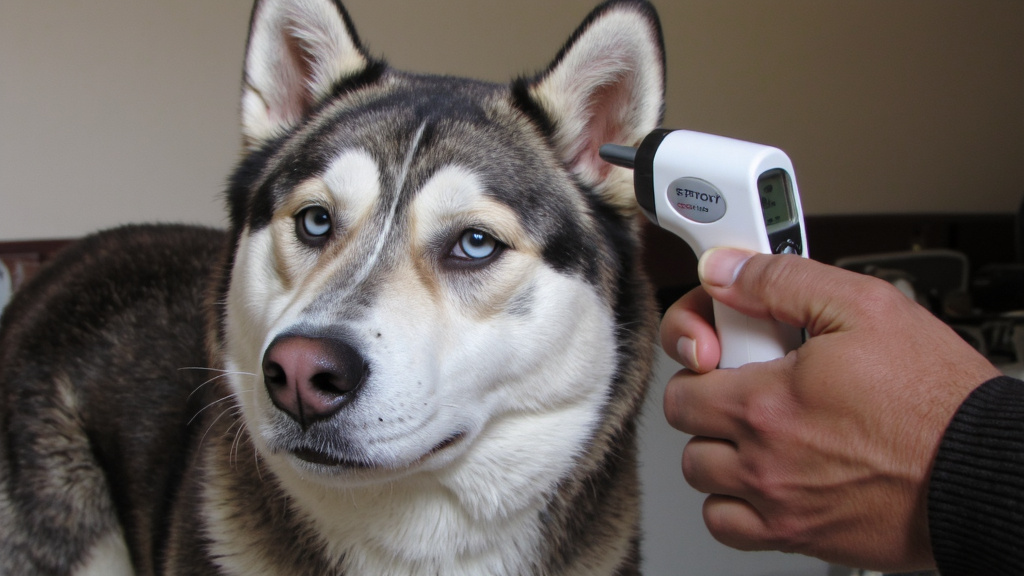
Dogs naturally run hotter than humans. However, when a dog’s temperature rises above 103°F, they have entered fever territory.
Unlike humans, one can’t simply place a hand on their forehead to get an accurate reading. Detecting a fever is also challenging because some dogs hide discomfort well. A German Shepherd who usually bounds across the dog park may just appear sluggish, rather than obviously ill.
How Can You Tell If Your Dog Has a Fever at Home?
Dogs can’t tell owners when they’re unwell, making fever detection challenging. Unlike humans, placing a hand on a dog’s forehead doesn’t indicate elevated temperature. A dog’s normal body temperature ranges from 101°F to 102.5°F—higher than the human baseline of 98.6°F.
Some owners believe checking the dog’s nose provides reliable insight—assuming a warm, dry nose indicates fever while a cold, wet nose signals good health. This myth persists despite evidence that nose temperature fluctuates based on environment, activity, and hydration rather than illness.
Using a Digital Thermometer: The Most Accurate Method
The most reliable way to detect dog fever at home involves using a digital thermometer specifically designed for rectal use in canines. Store this thermometer separately from human supplies for hygiene. When a dog shows signs of illness like lethargy or decreased appetite, follow these steps:
- Gather supplies: digital thermometer, water-soluble lubricant (petroleum jelly works in a pinch), and treats for afterward.
- Apply lubricant generously to the thermometer tip to ensure comfortable insertion.
- Recruit someone to gently hold the dog’s head and provide reassurance during the process.
- Carefully lift the dog’s tail and insert the thermometer about one inch into the rectum.
- Hold the thermometer steady until it beeps, typically less than 60 seconds.
- Remove gently and read the temperature.
Any reading above 103°F generally indicates elevated temperature requiring attention. Temperatures exceeding 106°F constitute a medical emergency necessitating immediate veterinary care.
Physical Signs That May Accompany Fever
While the thermometer provides definitive confirmation, these physical symptoms often accompany canine fever:
- Unusual lethargy or depression
- Reduced interest in food or water
- Excessive panting without exercise
- Shivering despite normal room temperature
- Red or glassy-looking eyes
- Warm ears (warmer than usual)
Remember these symptoms alone don’t confirm fever—physical activity can temporarily raise body temperature. Even an anxious visit to the clinic can elevate temperature readings.
Alternative Temperature-Taking Methods
If rectal temperature measurement proves too challenging, the axillary method offers a less invasive alternative. Place the thermometer in the dog’s armpit, hold the leg down against their body, and add approximately one degree to the reading. While convenient, this approach sacrifices accuracy and should only serve as preliminary screening.
Commercial ear and infrared thermometers marketed for pets exist but generally provide less reliable readings than the rectal method. When dealing with potential illness, precision matters—one degree can make the difference between normal variation and concerning fever.
What are common dog fever symptoms to watch for?

When a dog isn’t feeling well, fever might be the cause of unusual behavior. Unlike humans who can communicate discomfort, dogs rely on owners to recognize distress signals. A temperature above 103°F indicates fever in dogs, exceeding the normal canine range of 101-102.5°F.
Recognizing fever symptoms early can significantly aid a dog’s recovery. Key signs to monitor include:
Physical Signs of Fever
Noticeable physical symptoms include:
- Warm ears and nose – A cold, wet nose isn’t always a health indicator, but an unusually warm, dry nose can signal fever
- Red or glassy-looking eyes – Eyes may appear bloodshot or glassy
- Shivering – In warm environments, a feverish dog might tremble or shiver
- Excessive panting – Panting without exertion or heat exposure can indicate fever
- Runny nose – Nasal discharge often accompanies fever, especially with respiratory infections
Behavioral Changes
Equally important are changes in a dog’s behavior:
- Lethargy or decreased energy – A normally active dog suddenly sleeping all day might be fighting a fever
- Loss of appetite – Refusing favorite treats or skipping meals is a common fever symptom
- Increased water consumption – Some dogs with fever drink more water than usual
- Seeking cool surfaces – Lying on tile floors or cool surfaces to regulate temperature
Digestive and Respiratory Symptoms
Fever can affect multiple body systems, leading to:
- Vomiting – Occasional or persistent vomiting might accompany fever
- Diarrhea – Changes in stool consistency or frequency can indicate infection with fever
- Coughing – Typically with respiratory infections causing fever
These symptoms rarely appear in isolation. For example, a playful Labrador who loses interest in fetch, feels warm, and refuses dinner exhibits a cluster of symptoms strongly suggesting fever. A normally food-motivated terrier sleeping excessively, with glassy eyes, and panting without exercise may be experiencing temperature elevation.
While a warm nose alone might not indicate fever, multiple signs warrant closer attention. Detecting several symptoms together calls for a temperature check with a rectal thermometer or veterinary care. Avoid giving human fever reducers like ibuprofen or acetaminophen, as they are toxic to dogs and can cause serious harm.
When Should Dog Owners Be Concerned About Temperature For A Dog Fever?
Dogs naturally have higher body temperatures than humans, whose typical range is 97.6-99.6°F. A healthy dog’s normal temperature is 99.5-102.5°F. When it exceeds 103°F, the dog is experiencing a fever and requires close attention.
Readings above 103°F indicate that the dog’s body is likely fighting an infection or inflammation. This natural defense mechanism, while crucial, needs monitoring to prevent complications.
Sometimes, determining the cause of a dog’s fever can be challenging. Veterinarians may diagnose FUO (Fever of Unknown Origin), necessitating further testing for issues like cancer, bone marrow problems, or immune disorders.
What Should Dog Owners Do If They Notice Dog Fever Symptoms?

When a dog appears unusually warm or lethargic, instincts as a dog owner likely kick into high alert. Unlike humans, dogs can’t simply communicate when they’re feeling unwell, so recognizing fever symptoms early can significantly impact their recovery.
Immediate Home Care Steps
If the dog’s temperature is between 103°F and 104°F, provide initial care at home while preparing for a veterinary visit:
- Apply cool (not cold) water with a soaked towel to the dog’s paws and ears
- Run a fan near the dog to help lower body temperature
- Encourage small, frequent water intake to prevent dehydration
- Monitor temperature regularly, stopping cooling efforts once it drops below 103°F
- Provide a quiet, comfortable resting area with minimal activity
These measures are temporary solutions while arranging professional care. A persistent fever needs veterinary attention regardless of initial success in bringing it down.
When To Seek Immediate Veterinary Care
Certain situations warrant emergency veterinary intervention. Rush the dog to the vet if:
- Temperature exceeds 104.5°F
- Fever accompanies vomiting or bloody diarrhea
- The dog shows signs of severe lethargy or collapse
- There is difficulty breathing
- The fever persists for more than 24 hours
- The dog refuses to drink water
A temperature of 106°F or higher represents a life-threatening emergency that can damage internal organs. Do not attempt to manage this at home.
| Bacterial, Fungal, or Viral Infection | Coughing Runny nose Vomiting |
| Tooth Infection or Abscess | Decreased energy Loss of appetite |
| Ear Infection | Shivering Warm ears Decreased energy |
| Urinary Tract Infection | Frequent urination Blood in urine (not a symptom of fever but indicative of UTI) |
| Ingestion of Poisonous Substances | Vomiting Diarrhea Panting |
What To Expect At The Veterinary Visit
Your veterinarian will conduct a thorough examination to identify the underlying cause of the dog’s fever. This typically includes:
Blood work to check for infection and evaluate organ function. Many bacterial infections trigger an elevated white blood cell count detectable through routine blood screening. Urinalysis might reveal urinary tract infections, commonly causing fever in dogs.
Imaging tests such as X-rays or ultrasounds may be necessary if pneumonia, an abscess, or internal organ inflammation is suspected. In some cases, the cause remains elusive despite testing, leading to what veterinarians call a “fever of unknown origin.”
Dangerous Home Treatments To Avoid
Safety warning: never give a dog human fever-reducing medications. Medications like acetaminophen (Tylenol), ibuprofen (Advil), or aspirin are toxic to dogs and can cause serious kidney damage, liver failure, or even death. What helps humans can kill dogs.
Avoid using alcohol rubs, ice baths, or very cold water, as these can cause rapid temperature drops that stress the dog’s system further.
Recovery and Follow-Up Care
After diagnosis, the veterinarian will treat the underlying cause of the fever. This might include antibiotics for bacterial infections, anti-inflammatory medications, or specific treatments depending on the diagnosis.
During recovery, maintain good hydration by encouraging the dog to drink fresh water. Follow the vet’s medication instructions precisely, completing the full course even if the dog seems better. Schedule any recommended follow-up appointments to ensure the treatment has been successful.
Swift action when fever symptoms are noticed can prevent minor issues from becoming serious health crises. By knowing what to look for and responding appropriately, the best possible care is provided for four-legged family members.
Recognizing and Responding Early: Essential Steps for Your Dog’s Health
A dog owner’s vigilance is key—it’s the small changes in the dog’s behavior or body language that often provide the first warning signs of a fever. Prompt attention to symptoms, combined with accurate temperature-taking and timely veterinary care, puts the owner in the best position to support the dog’s recovery and prevent complications.
Incorporating preventive tools into the routine can further safeguard the pet’s well-being. For example, a smart solution like the Halo Collar offers added peace of mind by setting safe boundaries and monitoring the dog’s activity; this increased awareness can help notice subtle changes in routines that might signal illness before it becomes serious.
Staying proactive and educated about canine health is a strong way to advocate for the dog’s happiness and longevity. For more tips and resources on keeping dogs healthy, visit the Dog Health page for expert guidance and up-to-date advice.





